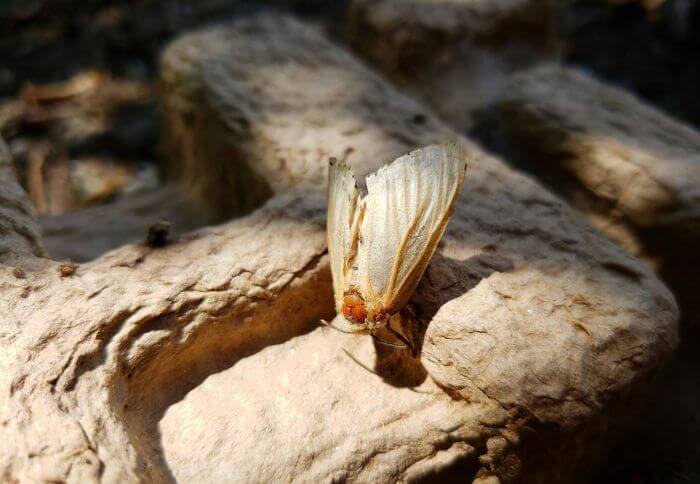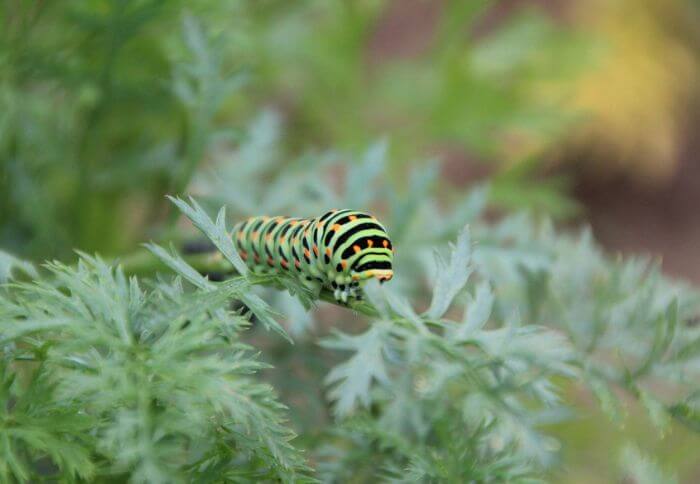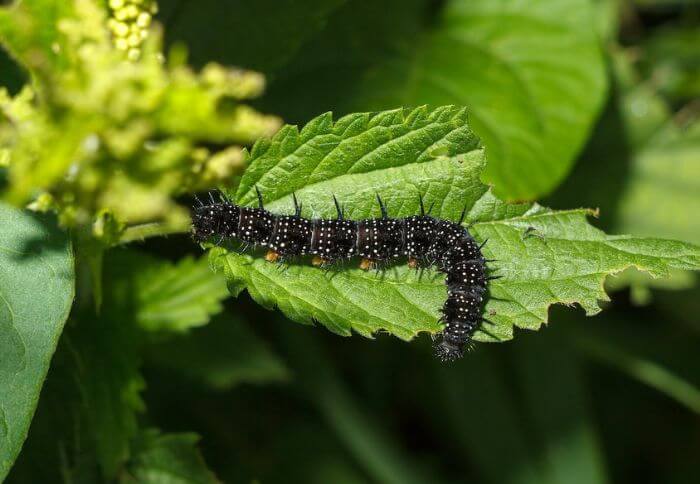Green Caterpillar in California (15 Species)
California is known for its stunning landscapes, from the towering redwoods to the golden beaches. But amidst this natural beauty, a fascinating phenomenon has been unfolding – green caterpillars have taken center stage in the state’s ecosystem.
These vibrant creatures, with their bright lime-green bodies and intricate patterns, have captured the attention of residents and experts alike, sparking curiosity and wonder about their origin and significance.
As they traverse through California’s diverse habitats, leaving trails of chewed leaves in their wake, these green caterpillars are revealing not only their own story but also shedding light on the delicate balance of nature that exists within the Golden State. Join us as we explore this captivating tale of California’s green caterpillars and uncover the secrets they hold.
Green Caterpillar in California
1. Western Tiger Swallowtail Caterpillar (Papilio rutulus)
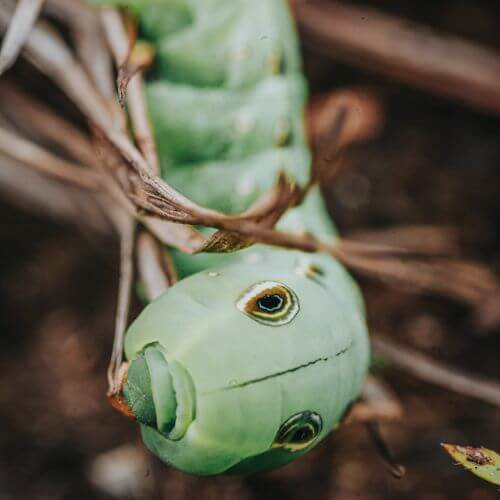
The Western tiger swallowtail butterfly is a breathtaking species found in California. Its vibrant yellow wings adorned with black stripes make it a remarkable sight to behold. But…
Did you know that the Western tiger swallowtail undergoes a fascinating metamorphosis? It starts life as an inconspicuous green caterpillar but transforms into a stunning creature of the sky.
One interesting observation about this species is its ability to mimic other butterflies. The Papilio rutulus has been observed imitating the toxic Pipevine swallowtail, fooling predators into thinking it is also unpalatable.
This clever defense mechanism allows it to avoid becoming prey while enjoying a peaceful flight through meadows and gardens.
In addition to its deceptive tactics, the Western Tiger Swallowtail plays an important role in pollination. As they flutter from flower to flower in search of nectar, they inadvertently transfer pollen grains and contribute to plant reproduction.
This mutualistic relationship between butterflies and plants highlights their vital ecological significance.
So next time you spot a green caterpillar inching along a leaf in California, remember that it might just be on its way to becoming one of nature’s most enchanting creatures – the Papilio rutulus, ready to bring beauty and wonder into your surroundings.
2. Ceanothus Silkmoth Caterpillar
Ceanothus Silkmoth caterpillars are no ordinary caterpillars; they are a true marvel of nature. Found exclusively in California, this vibrant green creature can be spotted munching on the leaves of the majestic Ceanothus shrub.
Its vivid coloration serves as a warning sign to potential predators, signaling that it is toxic to eat. This unique defense mechanism makes this green California caterpillar stand out from other caterpillars and showcases its remarkable adaptation for survival.
But what truly captivates me about this caterpillar is its intricate metamorphosis process. After feasting on vegetation for weeks, the green creature retreats into a chrysalis and undergoes an incredible transformation.
Inside this protective shell, magic happens—the caterpillar dissolves into a liquid-like substance before reorganizing and rebuilding itself into an ethereal silk moth. It is awe-inspiring to witness how such humble beginnings can result in such extraordinary beauty.
Next time you find yourself amidst the breathtaking landscapes of California, keep an eye out for the vibrant green presence of the ceanothus silkmoth Caterpillar.
As you witness its astonishing metamorphosis unfold, let it serve as a reminder of the enchantment found within even the smallest creatures of our natural world—an inspiration to embrace change and appreciate all forms of life around us.
3. White-lined Sphinx Caterpillar (Hyles lineata)
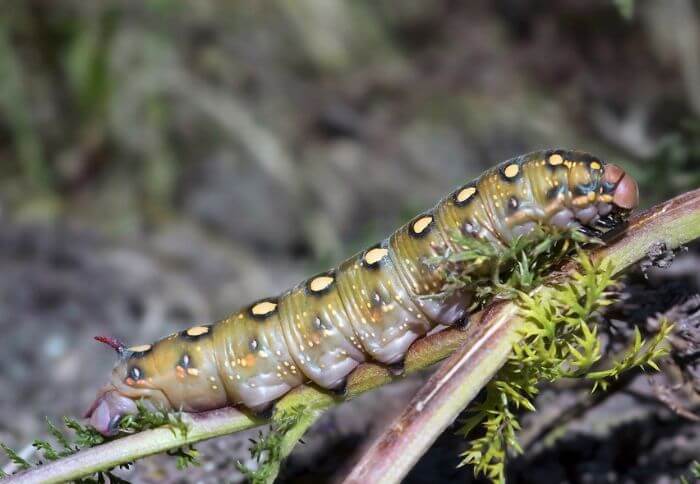
One of the most fascinating caterpillars found in California is the white-lined Sphinx moth caterpillar. With its vibrant green body and distinctive white lines running along its sides, it is truly a sight to behold.
This striking appearance serves as a form of camouflage, allowing the caterpillar to blend seamlessly into its surroundings and evade potential predators.
What sets the white-lined sphinx caterpillar apart from others is its unique feeding behavior. Unlike many other caterpillars that prefer specific plants or foliage, this species is not picky and will feed on a wide variety of plants.
From desert wildflowers to weedy grasses, it seems as though these voracious eaters can adapt to almost any environment. This adaptability not only ensures their survival but also plays a crucial role in maintaining the ecological balance within their habitat.
Furthermore, another intriguing characteristic of these caterpillars is their remarkable ability to withstand unfavorable conditions such as drought or extreme temperatures.
During periods of scarcity or adverse weather conditions, they have been known to enter diapause – a state of dormancy similar to hibernation – where they remain inactive until more favorable environmental conditions return.
This incredible adaptation allows them to conserve energy and survive in even the harshest environments.
4. Regal Moth Caterpillar (Citheronia regalis)
The royal walnut moth caterpillar is a true spectacle of nature found in the state of California. With its vibrant green coloration and striking patterns, it quickly captures the attention of anyone lucky enough to spot it in its natural habitat.
This particular species can be found feeding on various deciduous trees such as walnut, apple, and sweetgum.
What truly makes the regal moth caterpillar fascinating is not only its appearance but also its size. Growing up to an impressive 4 inches long, it dominates the foliage with its large presence.
As it munches away at leaves, you may notice tiny spiky hairs covering its body for protection from predators. These hairs are not only a defense mechanism but also give this creature a unique texture that sets it apart from other native caterpillars in California.
It’s worth noting that despite their enchanting appearance, these magnificent creatures have relatively short lives as adults once they go through metamorphosis. Their adult stage lasts for just one or two weeks when they emerge as beautiful moths with intricately patterned wings that resemble tree bark.
As we appreciate this fleeting beauty, let us remember to cherish these green caterpillars of California and ensure their habitats are protected for future generations to marvel at these incredible insects.
5. Cabbage Butterfly Caterpillar (Pieris rapae)
The cabbage white butterfly caterpillar is a common sight in gardens across California. This small green creature may not seem like much at first glance, but it plays a crucial role in the ecological balance of our ecosystems.
Despite its name suggesting a preference for cabbage plants, the small white caterpillar can actually be found feeding on various brassica species such as broccoli and kale.
What makes this little caterpillar fascinating is its ability to adapt to different environments. It has been known to thrive in urban areas, where it feeds on ornamental kale and collard greens planted by gardeners.
This adaptability allows the Pieris rapae caterpillar to survive and reproduce in diverse locations, proving that nature often finds innovative ways to thrive even amidst human development. Furthermore, their presence can attract beneficial predators like birds and wasps that help maintain pest populations in check.
Overall, although commonly overlooked or even dismissed as just another garden pest, the small white caterpillar deserves more attention for its resilience and environmental significance.
Its role within California’s ecosystem highlights the interconnectedness of all living organisms and reminds us of nature’s remarkable ability to adapt and persist against all odds. So next time you spot one of these green creatures munching away on your plants, take a moment to marvel at its tenacity and appreciate its contribution to the intricate web of life around us.
6. Blue Copper Caterpillar (Lycaena heteronea)
Another common type of green caterpillar in California is the blue copper caterpillar. Its vibrant green coloration stands out amidst the surrounding foliage, making it an absolute delight to spot during nature hikes.
What sets this caterpillar apart from others is its unique feeding behavior – it predominantly feeds on needle-like leaves of certain plants such as buckwheat and lupine. This specialization in diet allows for their survival even in areas where other caterpillars might struggle.
Interestingly, this California caterpillar has a fascinating adaptation that helps them evade predators. When threatened, they have the ability to create a buzzing or hissing noise by rubbing their mandibles together.
This unexpected defense mechanism startles potential predators and gives the caterpillar time to escape unscathed. Additionally, their bright green color serves as a form of camouflage amongst the lush vegetation, making it difficult for predators to locate them.
7. Gray Hairtstreak Caterpillar (Strymon melinus)
The Gray Hairstreak butterfly caterpillar may be small, but its impact on the natural world is significant. This tiny creature can be found across California, and its distinctive grayish-green coloring helps it blend seamlessly with its environment.
But what sets this caterpillar apart is its ability to adapt and survive in a variety of habitats. From urban gardens to wild meadows, the Gray Hairstreak has managed to find a niche wherever it goes.
Another important fact to know about this green caterpillar in California is the aspect of its lifecycle in relationship with ants. These clever insects have formed a mutualistic partnership with the caterpillar, providing protection in exchange for sweet secretions known as honeydew.
The caterpillars produce these sugary droplets which provide nourishment for the ants while gaining an army of bodyguards in return. This unique symbiotic relationship ensures that the caterpillars are well-protected from predators, allowing them to focus their energy on growth and development.
Another intriguing feature of this species is its ability to undergo multiple molts before transforming into a butterfly.
As it grows larger and consumes more food, the gray hairstreak caterpillar sheds its old skin several times, revealing a fresh new exoskeleton each time. This process, known as ecdysis, allows the caterpillars to accommodate their expanding bodies and continue their remarkable transformation journey.
8. Anise Swallowtail Caterpillar (Papilio zelicaon)
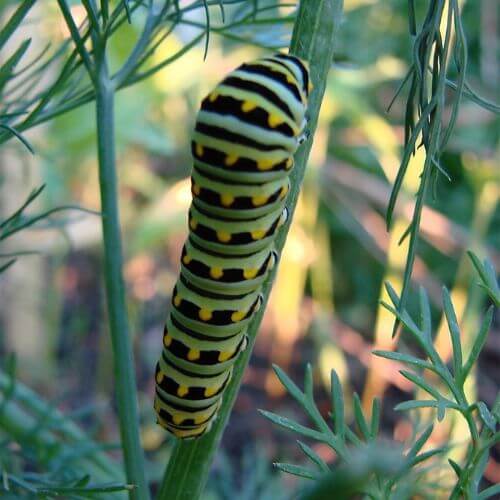
One of the most recognizable caterpillars of California is the anise swallowtail caterpillar. This distinct green caterpillar sports black bands adorned with vibrant yellow spots that make it easily recognizable.
What may surprise you is that their striking appearance serves as a form of protection. These cunning caterpillars mimic bird droppings to ward off potential predators, making them less appetizing targets.
As these clever critters feast on plants like fennel and parsley, they grow rapidly in size. At each stage of molting, this green California caterpillar sheds its skin, revealing a bright yellow-green body underneath. The process continues until it reaches its mature stage or chrysalis phase—a pivotal transformation before becoming a beautiful adult butterfly.
9. Common-wood Nymph Caterpillar (Cercyonis pegala)
The common wood-nymph caterpillar may appear unassuming at first, but its understated appearance belies a remarkable ability to blend seamlessly into its surroundings. With its mottled brown and green coloring, this caterpillar mimics the foliage it feeds on, making it nearly invisible to predators.
As it matures, this green caterpillar in California undergoes a fascinating transformation: from a small, inconspicuous creature to a breathtakingly beautiful butterfly.
One of the most intriguing aspects of the common wood-nymph caterpillar is its feeding behavior. Rather than consuming leaves like many other caterpillars, it primarily relies on specific grass species for sustenance.
This specialization highlights the intricate relationship between this insect and its chosen habitat. By showing such selectivity in their diet, these caterpillars play an important role in maintaining healthy grassland ecosystems.
10. Silvery Blue Butterfly Caterpillar
The Silvery Blue Butterfly caterpillar is a captivating creature found in the lush landscapes of California. With its green coloration and delicate hairs, it easily stands out among other caterpillars.
What makes this species even more fascinating is its unique diet – while most caterpillars feed on leaves or plants, the silvery blue butterfly caterpillar exclusively feasts on flowers.
Also, the female butterfly carefully selects specific flowers for egg-laying, which will serve as future food sources for her offspring.
This highly specialized diet not only ensures that the developing caterpillars receive essential nutrients but also plays a crucial role in pollination within their habitat. This green California caterpillar becomes an unwitting but vital ambassador for these flowers by transferring pollen from one flower to another as it moves along its feeding journey.
11. Carolina Sphinx Caterpillar
One intriguing caterpillar species found in California is the Carolina Sphinx Caterpillar (Manduca sexta). With its vibrant lime green body and fascinating horn-like protrusion at the end, this caterpillar is sure to catch your eye.
But it’s not just its appearance that makes it remarkable; the Carolina sphinx caterpillar has some unique behaviors and adaptations that set it apart from other caterpillars.
To protect itself, when faced with a potential predator, such as a bird or wasp, the Carolina Sphinx Caterpillar can inflate its body by taking in air through small openings called spiracles.
This inflation makes the caterpillar appear larger and more intimidating, potentially scaring off would-be attackers. Additionally, these caterpillars are known for their incredible speed – they can move rapidly when disturbed, making them difficult targets for predators.
13. Orange Sulphur Moth Caterpillar
Known for its long body, the orange sulphur moth caterpillar is another green insect that can be spotted throughout California. With its green hue and yellowish lines, it stands out amongst the green foliage.
This caterpillar has a unique life cycle, starting as an egg laid on the leaves of various host plants such as clover and alfalfa. As it grows, the caterpillar goes through several molts, shedding its old skin to reveal a bright orange body. It spends most of its time munching on leaves to fuel its growth.
Also, when disturbed or threatened, this caterpillar has the remarkable ability to lighten or darken its hue in order to blend in with its surroundings and avoid predators.
This adaptability not only helps ensure its survival but also provides researchers with valuable insights into camouflage techniques used by other species in nature.
14. California Sister Caterpillar
The California Sister Caterpillar is a fascinating creature that is often overlooked in the bustling world of caterpillars. With its bright green color and intricate patterns, it stands out among its peers.
But what sets this caterpillar apart is not just its appearance, but also its unique behavior. Unlike most caterpillars that munch on leaves all day, the California Sister Caterpillar prefers a more adventurous diet. It has been observed feasting on various fruits and even flower petals, making it a versatile and adaptable species.
Another intriguing fact about the California sister caterpillar is its ability to camouflage itself with its surroundings. When threatened or disturbed, it has the remarkable ability to change its color to blend in perfectly with leaves or branches.
This defense mechanism not only protects it from predators but also allows it to go unnoticed by curious human observers. This caterpillar truly embodies the phrase survival of the fittest, adapting to different environments and overcoming obstacles for its own survival.
Despite being relatively unknown, the California Sister Caterpillar demonstrates an incredible resilience and adaptability that deserves recognition. Its vibrant appearance, diverse diet, and incredible ability to camouflage make it a truly captivating creature worth studying further
15. Hemlock Moth Caterpillar
The hemlock moth caterpillar, also known as the poison-hemlock defoliator, is a fascinating creature that can be found in various parts of California. While its name might sound ominous, this vibrant green caterpillar has an intriguing life cycle and unique defense mechanisms.
One of the most interesting aspects of the hemlock moth caterpillar is its diet. As its name suggests, it primarily feeds on hemlock trees, but it’s not picky – it may also munch on other members of the parsley family. Its voracious appetite and ability to devour large quantities of leaves can have a significant impact on affected vegetation.
But what truly sets this caterpillar apart from others is its striking appearance. Sporting bright green coloration with black spots along its body, it almost seems like a critter straight out of a psychedelic dream. This bold coloring serves as both camouflage and warning signal to predators: I am toxic!
Final Thoughts:
The green caterpillar in California is a fascinating creature that plays an important role in the ecosystem. Its vibrant green color and distinct patterns make it easily distinguishable from other caterpillar species.
While it may be considered a pest by some due to its appetite for plants, it also serves as a valuable food source for birds and other animals.
By understanding and appreciating the diversity of insects like the green caterpillar, we can gain a deeper appreciation for the natural world around us. Let us continue to protect and preserve these delicate creatures and their habitats, ensuring their presence for future generations to enjoy.
Sources:
https://entnemdept.ufl.edu/creatures/bfly/regal_moth.htm
Passionate animal photographer with an unwavering love for capturing the essence and beauty of our furry friends.
With over five years of experience in the field, I have developed a unique ability to connect with animals on a deeper level, allowing me to create stunning and captivating images that truly reflect their personality.
Let’s collaborate to capture unforgettable moments that celebrate the unique bond between humans and animals!
